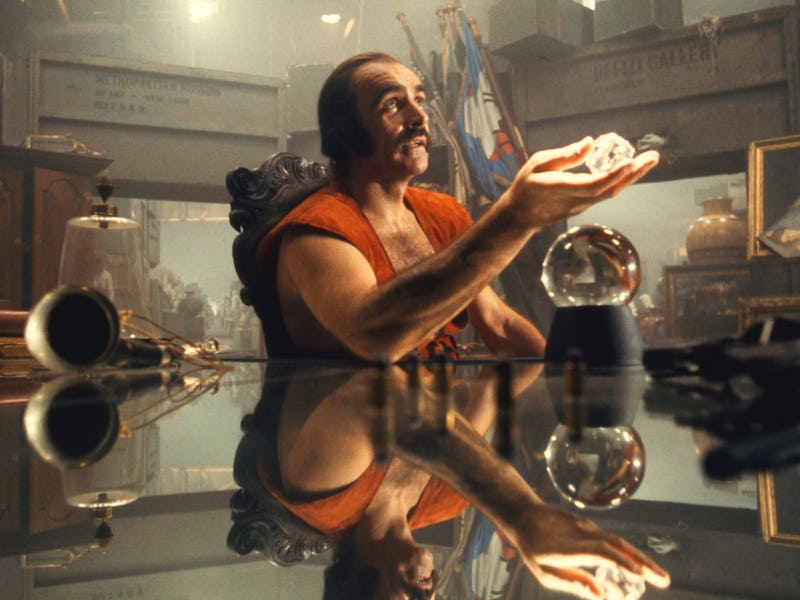The Sci-Fi Dystopia Where Sean Connery Wears a Diaper Is Surprisingly Thoughtful
There’s no escaping Connery’s aura when he’s wearing thigh-highs.

If you’re even remotely interested in kitschy sci-fi imagery, you’ve likely seen Sean Connery wearing what can only be described as post-apocalyptic red diapers, matching boots, and bandoliers. This is the enduring image of Zardoz, a bizarre 1974 science fiction film in which Connery’s most outrageous outfit is actually a wedding dress.
Zardoz is the exact opposite of an instant classic; it’s such a slow burn that it may take another 50 years to be considered the 20th century’s most underrated sci-fi movie. When it was released on February 6, 1974, it was a bomb. As reported by Starlog, some people leaving the theater would supposedly advise others waiting for the next showing to not bother. Throw in mixed reviews, and Zardoz was DOA. But five decades later, parts of Zardoz are not only artistically brilliant but socially prescient.
Watching Zardoz today, one gets the sense that director John Boorman crafted the film to be purposely misunderstood. It begins with an absurd meta-fictional narrator (Niall Buggy) who calls himself both Zardoz and Arthur Frayn. He warns the audience that what we’re about to watch is only half-true, and mockingly implies we have no free will, saying, “Is God in show business too?” Then the movie gets going, and a giant stone head issues weapons to cult-like warriors, all wearing their diapers and bandoliers. These are basically murderous incels organized into a bizarre cult and tasked with keeping the downtrodden human population of the “Outlands” in line.
One of these Exterminators, Zed (Sean Connery), gets curious, hides in the stone head, shoots an in-universe version of Frayn, and finds himself in the Vortex, a place where privileged humans live immortal lives of leisure. As two Eternals — Consuella (Charlotte Rampling) and May (Sara Kestelman) — probe Zed’s mind, we learn the film’s most essential twist. The Eternals rely on the less privileged “Brutals” to supply them with food, the gun-obsessed cult of Zardoz is a social construct crafted by Frayn to keep the Brutals pliant, and Exterminators like Zed do their dirty work.
When Consuella says she’s “always voted against forced farming,” May reminds her, “You eat the bread.” Essentially, Zardoz plays with the idea that toxic, aggressive (and mostly male) behaviors are both despicable and weaponized by elites. In fact, in a Dune-esque development, we later learn that Frayn helped create Zed through a controlled breeding program, with the goal of making him some kind of liberator.
Sean Connery rocks the most iconic — or absurd — look in all of science fiction. Take your pick.
It’s here, in this basic story detail, that the film is most challenging. There’s nearly no character to root for, since they’re all unlikable, either by design, necessity, or both. Save for Frayn, none of the people in Zardoz have self-awareness, which requires the audience to accept the earlier statement that this is a work of satire. If Zardoz is indeed satirical, it goes about its satire with a deep faux-earnestness, which makes it both laugh-out-loud ridiculous and occasionally disturbing.
As Zed is introduced to the Eternals’ culture, the second major twist of the film is unfurled; through too much technological and biological innovation, they can never die. Zed becomes an anti-hero, bringing a kind of death cult to the Vortex that theoretically affirms the film’s vaguely humanist message. One reading of Zardoz is that life has no meaning if it’s eternal, and therefore procreation and death are two sides of the same life coin.
Just another day on the job.
But ascribing that kind of moralist message to Zardoz is unfair. While we’re encouraged to believe that the love between Zed and Consuella could eventually result in a better version of humanity, the movie’s artifice is too strange and heavy-handed to allow for a singular, ethical reading of its meaning. Instead, the purpose of Zardoz seems to be provocation. Boorman is determined to say something about sexual violence, but it’s unclear what, other than to occasionally float the premise that Connery is hot and everyone else is a prude. If the movie is mocking the audience for buying this premise, then it’s genius. If it’s just depicting this idea, then it’s borderline offensive. Can both things be true about Zardoz? You bet!
After five decades, Zardoz still can’t settle its own debate. It’s either a mildly pornographic sci-fi movie about the dangers of too much technology, or a pervasive and clever attack on classism and the need for adventure narratives to fire people up. But unlike the thudding metaphors of many other sci-fi films of both the ’70s and today, Zardoz doesn’t let you have it all one way. You can have deep thoughts about Zardoz, but there’s a cost: you’re gonna have to wear the red diapers and get inside the stone head to figure it all out.